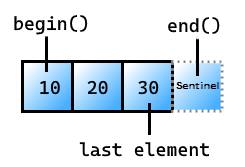drop_while_view class (C++ Standard Library)
A view that contains the elements of a range that remain once the leading elements that match a predicate are dropped.
Syntax
template<ranges::view V, class P>
requires ranges::input_range<V> &&
std::is_object_v<P> &&
std::indirect_unary_predicate<const P, ranges::iterator_t<V>>
class drop_while_view : public ranges::view_interface<drop_while_view<V, P>>;
Template parameters
V
The type of the underlying view.
P
The type of the predicate that determines the leading elements to drop.
View characteristics
For a description of the following entries, see View class characteristics
| Characteristic | Description |
|---|---|
| Range adaptor | views::drop_while |
| Underlying range | Must satisfy forward_range or higher and the underlying range's iterators must model sized_sentinel_for |
| Element type | Same as the underlying range |
| View iterator category | Same as the underlying range |
| Sized | Only if the underlying range satisfies random_access_range |
Is const-iterable |
No |
| Common range | Only if the underlying range satisfies common_range |
| Borrowed range | Only if the underlying range satisfies borrowed_range |
Members
| Member functions | Description |
|---|---|
| Constructors | Construct the view. |
base |
Get the underlying view. |
begin |
Get an iterator to the first element. |
end |
Get the sentinel at the end of the view. |
pred |
Get a reference to the predicate that determines which elements to drop. |
| Inherited from view_interface | Description |
backC++20 |
Get the last element. |
dataC++20 |
Get a pointer to the first element. |
emptyC++20 |
Test whether the view is empty. |
frontC++20 |
Get the first element. |
operator[]C++20 |
Get the element at the specified position. |
operator boolC++20 |
Test whether the view isn't empty. |
size |
Get the number of elements in the view. |
Requirements
Header: <ranges> (since C++20)
Namespace: std::ranges
Compiler Option: /std:c++20 or later is required.
Constructors
Construct an instance of a drop_while_view.
1) constexpr drop_while_view(V base, P pred);
2) drop_while_view() requires default_initializable<V> && default_initializable<P> = default;
Parameters
base
The underlying range.
pred
The predicate that determines the leading elements to drop.
For information about the template parameter types, see Template parameters.
Return value
A drop_while_view instance.
Remarks
The best way to create a drop_while_view is by using the views::drop_while range adaptor. Range adaptors are the intended way to create view classes. The view types are exposed in case you want to create your own custom view type.
1) Move constructs the drop_while_view from a base view and a pred predicate. Both base and pred are moved via std::move().
2) Default-constructs a drop_while_view.
Example: drop_while_view
// requires /std:c++20 or later
#include <ranges>
#include <vector>
#include <iostream>
void print(auto v)
{
for (auto& x : v)
{
std::cout << x << ' ';
}
std::cout << '\n';
}
int main()
{
std::vector<int> v{ 0, 1, 2, 3, -4, 5, 6 };
auto myView = std::views::drop_while(
v,
[](int i) {return i >= 0; });
print(myView); // -4 5 6
auto myView2 = v | std::views::drop_while(
[](int i) {return i < 5; });
print(myView2); // 5 6
}
-4 5 6
5 6
base
Get the underlying view.
// Uses a copy constructor to return the underlying view
constexpr V base() const& requires std::copy_constructible<V>;
// Uses std::move() to return the underlying view
constexpr V base() &&;
Parameters
None.
Returns
The underlying view.
begin
Get an iterator to the first element in the view.
constexpr auto begin();
Return value
An iterator pointing at the first element in the view. The behavior is undefined if the view doesn't have a predicate.

end
Get the sentinel at the end of the view.
constexpr auto end()
Return value
The sentinel that follows the last element in the view:

pred
Get a reference to the predicate that determines which leading elements to drop.
constexpr const Pred& pred() const;
Return value
A reference to the predicate.
Remarks
If the view doesn't store a predicate, the behavior is undefined.
Example pred
// requires /std:c++20 or later
#include <ranges>
#include <iostream>
#include <vector>
int main()
{
std::vector<int> v{ 0, 1, 2, 3, -4, 5, 6 };
auto mv = v | std::views::drop_while(
[](int i) {return i < 5; }); // drop the leading elements < 5
std::cout << std::boolalpha << mv.pred()(v[6]); // outputs "false" because v[6] = 6 and 6 is not less than 5 (the predicate)
}
false
See also
<ranges>
drop_while range adaptor
take_while range adaptor
take_while_view
view classes